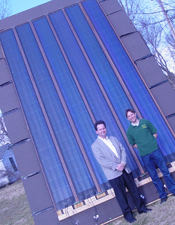UMR gets EPA grant to test hybrid solar panels
Posted by news
Joel Lamson, a graduate student at the University of Missouri-Rolla, has a black monolith, several stories high, in his back yard. But Lamson isn’t trying to recreate some science fiction scene; the monolith is really a newfangled solar panel engineered for a UMR research project.
 |
| Dr. Stuart Baur (left) and graduate student Joel Lamson pose in front of a huge hybrid solar panel they’re testing in Lamson’s back yard. |
The U.S. Environmental Protection Agency recently awarded UMR a $10,000 grant to support the project, which involves the continued testing of solar-thermal electric panels like the one that is propped up at an impressive angle in Lamson’s back yard to catch the sun’s rays.
Most solar houses have separate systems to generate energy for hot water and electricity. The UMR panels, which were first used on the roof of a solar house that was entered in the U.S. Department of Energy’s 2005 Solar Decathlon competition, incorporate both hot water and electricity systems on the same surface.
Lamson, a mechanical engineering student from Orange, Calif., says the hybrid systems cost about the same and are about 1.5 times as efficient as the separated systems.
Aesthetic appeal is another factor in favor of the hybrid systems, according to Lamson.
“Once the system goes up on the roof, it doesn’t look like the house has solar panels,” Lamson says. “It looks thin and black, like roofing paper. The house we built was designed for real-world use.”
Although the UMR Solar House Team used the hybrid system on the roof of the house they displayed last fall during the Solar Decathlon event in Washington, D.C., they haven’t had time to fully study the system’s technical efficiencies.
Later this semester, UMR’s solar house will be reassembled in Rolla. The DOE will visit in June to re-install Solar Decathlon sensors for extended monitoring.
In the meantime, Lamson is testing the big panel in his back yard for the EPA. This May, his UMR research team will submit a report to the EPA and apply for a second phase of funding.
In the first phase, the EPA has funded 41 pollution prevention/sustainable development projects, including the UMR project. Only the top three will receive an additional grant of $75,000 in the second phase.
Chris Krueger, a sophomore in architectural engineering from St. Joseph, Mo., will travel to Washington with Lamson May 8-10 to deliver the UMR report and presentation to the EPA. They will be accompanied by the faculty researcher on the project, Dr. Stuart Baur, an assistant professor of architectural engineering at UMR.
“The hybrid system we’re working on is not widely used,” says Baur, who is hopeful the UMR team will make the cut and get a second round of funding from the EPA.
The EPA uses a panel of experts from the National Academy of Engineering to judge the projects.
The UMR Solar House Team is already planning for the next Solar Decathlon, which will be held in the fall of 2007 and is separate from the EPA competition. The 20 teams selected for the 2007 Solar Decathlon, including the UMR team, will be awarded $100,000 by the DOE and other sponsors over the next two years to support the construction of new solar houses.